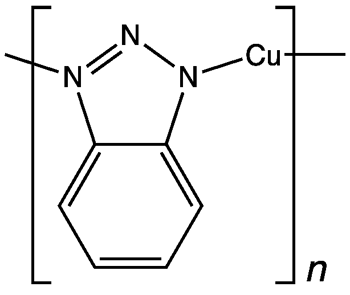 This is fifth in a series on corrosion control; find the other posts here.
This is fifth in a series on corrosion control; find the other posts here.
Corrosion inhibitors is a bit of an unfortunate term. One could rightly suggest that the entirety of corrosion control is focused on inhibiting corrosion, so any technique used within that umbrella could be called a corrosion inhibitor. Within the corrosion industry (yes, it is a proper industry), corrosion inhibitor refers to chemicals which are applied in low concentration, and which act in one or more of three ways:
- chemical absorption onto the surface of a metal to create a protective layer
- oxidation in the environment to create a protective layer
- reaction with a corrosive chemical within water to prevent it from reacting with the item being protected
This is only one of seemingly hundreds of ways of categorizing corrosion inhibitors (anodic vs. cathodic vs. both; organic vs. inorganic; and many more based on specific action mechanisms), but the point to be made here is that corrosion inhibitors are distinguished from procedures like chrome plating largely based on permanence, although that line blurrs when examining inhibitors which act using that first mechanism of chemical absorption.
There are myriad different corrosion inhibitor chemicals on the market today serving thousands of different applications. Phosphate for concrete; ammonia and morpholine for boilers; organic compounds like propargyl alcohol for the acid pickling of metal. The number of different compounds of corrosion inhibitor used within the oil and gas industry is staggering. Here is a breakdown of the industry from a recent paper on the subject:
Recent studies estimate that the U.S. demand for corrosion inhibitors will rise 4.1% per year to USD$ 2.5 billion in 2017. In 2012 they estimated that the market demand of inhibitors was divided on 26.6% to refining petroleum, 16.9% utilities, 16.7% gas and oil production, 15.3% chemical, 9.5% metals, 7.1% pulp and paper and 8.0% other.
It should not go unnoticed that these applications almost all have on thing in common: extreme environment. Or more appropriately to our current topic: extremely corrosive environment.
Corrosion inhibitors tend to be used in the most corrosive environments simply because there are few other solutions. They provide protection in places where simple galvanic protection is not enough, but where a full ICCP system would not be cost-effective. When other solutions, like plating, are either impossible or ineffective, corrosion inhibitors are often employed.
However, for a long time, the environmental cost of corrosion inhibitors had been ignored. As is often the case with chemicals, the most effective ones can be the most dangerous, and that proved true for many corrosion inhibitors, which have been either removed from the market or been made legally difficult to acquire. Scientists have made great strides in finding safer inhibitors, but some of the more dangerous ones are still in use, because of the extremely corrosive environments.

Drawing of chemical structure of Cu-benzotriazole polymer by Smokefoot via Wikimedia
Liberty Intercept Blog
Corrosion Control - Corrosion Inhibitors
Posted by Greg Spitz on Feb 16, 2017 9:16:44 AM
Corrosion inhibitors is a bit of an unfortunate term. One could rightly suggest that the entirety of corrosion control is focused on inhibiting corrosion, so any technique used within that umbrella could be called a corrosion inhibitor. Within the corrosion industry (yes, it is a proper industry), corrosion inhibitor refers to chemicals which are applied in low concentration, and which act in one or more of three ways:
This is only one of seemingly hundreds of ways of categorizing corrosion inhibitors (anodic vs. cathodic vs. both; organic vs. inorganic; and many more based on specific action mechanisms), but the point to be made here is that corrosion inhibitors are distinguished from procedures like chrome plating largely based on permanence, although that line blurrs when examining inhibitors which act using that first mechanism of chemical absorption.
There are myriad different corrosion inhibitor chemicals on the market today serving thousands of different applications. Phosphate for concrete; ammonia and morpholine for boilers; organic compounds like propargyl alcohol for the acid pickling of metal. The number of different compounds of corrosion inhibitor used within the oil and gas industry is staggering. Here is a breakdown of the industry from a recent paper on the subject:
It should not go unnoticed that these applications almost all have on thing in common: extreme environment. Or more appropriately to our current topic: extremely corrosive environment.
Corrosion inhibitors tend to be used in the most corrosive environments simply because there are few other solutions. They provide protection in places where simple galvanic protection is not enough, but where a full ICCP system would not be cost-effective. When other solutions, like plating, are either impossible or ineffective, corrosion inhibitors are often employed.
However, for a long time, the environmental cost of corrosion inhibitors had been ignored. As is often the case with chemicals, the most effective ones can be the most dangerous, and that proved true for many corrosion inhibitors, which have been either removed from the market or been made legally difficult to acquire. Scientists have made great strides in finding safer inhibitors, but some of the more dangerous ones are still in use, because of the extremely corrosive environments.
Drawing of chemical structure of Cu-benzotriazole polymer by Smokefoot via Wikimedia
Topics: Corrosion Control
Related Posts
Connections - the Weakest Link
New Corrosion Control Program
Portraying Polymers and CorrCon
Leave a Comment